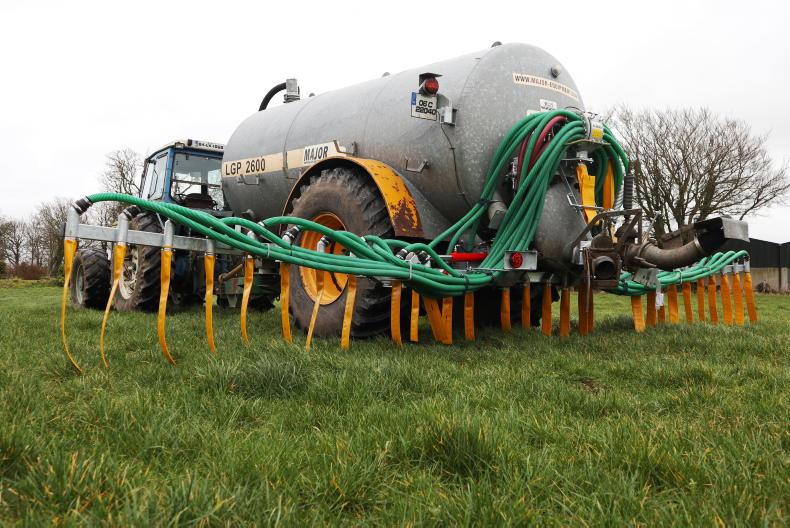As noted by Kieran Mailey on p52, tighter rules apply in NI when spreading slurry in February (and also in October) than at other times of the year.
In particular, farmers should keep 15m from a watercourse (usually 10m) and 30m from a lake (usually 20m). Where low-emission slurry spreading equipment (LESSE) is used the distance to a watercourse can be reduced to 5m (usually 3m).
There are also limits on how much slurry can be applied at any one time, with a maximum of 2,750 gallons per acre in February and October, compared to 4,500 gallons per acre in other months.
Debatable
Just how strictly these rules can be enforced is debatable, and it would seem particularly difficult for a DAERA inspector to identify and prove that a higher rate of slurry was applied than this 2,750 gallon limit, especially if LESSE is used.
But at the same time, farmers must proceed with caution during February, and for those with limited storage capacity, the initial aim should be to get tanks lowered, not emptied completely.
The long-range forecast looks reasonable, but it is likely to remain pretty cold, so it is questionable how well the nutrients in slurry will actually be used.
The danger is that if high rates of slurry are applied at a time when plant uptake is poor, nutrients (especially phosphorus) are lost to waterways, further compounding the issues we currently have with water quality in NI. Those who don’t pay heed to that are simply making it more likely that tougher rules will be imposed on all farmers in future years.
The other issue to be aware of is soil compaction. Even if land can be travelled, heavy machinery out on fields at this time of the year damages soil structure. A 2,000 gallon tanker full of slurry has up to 12t of weight on the axle.
Read more
Ammonia mitigation to transform NI agriculture
Listen: one-year lead time on tandem-axle tankers
As noted by Kieran Mailey on p52, tighter rules apply in NI when spreading slurry in February (and also in October) than at other times of the year.
In particular, farmers should keep 15m from a watercourse (usually 10m) and 30m from a lake (usually 20m). Where low-emission slurry spreading equipment (LESSE) is used the distance to a watercourse can be reduced to 5m (usually 3m).
There are also limits on how much slurry can be applied at any one time, with a maximum of 2,750 gallons per acre in February and October, compared to 4,500 gallons per acre in other months.
Debatable
Just how strictly these rules can be enforced is debatable, and it would seem particularly difficult for a DAERA inspector to identify and prove that a higher rate of slurry was applied than this 2,750 gallon limit, especially if LESSE is used.
But at the same time, farmers must proceed with caution during February, and for those with limited storage capacity, the initial aim should be to get tanks lowered, not emptied completely.
The long-range forecast looks reasonable, but it is likely to remain pretty cold, so it is questionable how well the nutrients in slurry will actually be used.
The danger is that if high rates of slurry are applied at a time when plant uptake is poor, nutrients (especially phosphorus) are lost to waterways, further compounding the issues we currently have with water quality in NI. Those who don’t pay heed to that are simply making it more likely that tougher rules will be imposed on all farmers in future years.
The other issue to be aware of is soil compaction. Even if land can be travelled, heavy machinery out on fields at this time of the year damages soil structure. A 2,000 gallon tanker full of slurry has up to 12t of weight on the axle.
Read more
Ammonia mitigation to transform NI agriculture
Listen: one-year lead time on tandem-axle tankers







 This is a subscriber-only article
This is a subscriber-only article










SHARING OPTIONS: